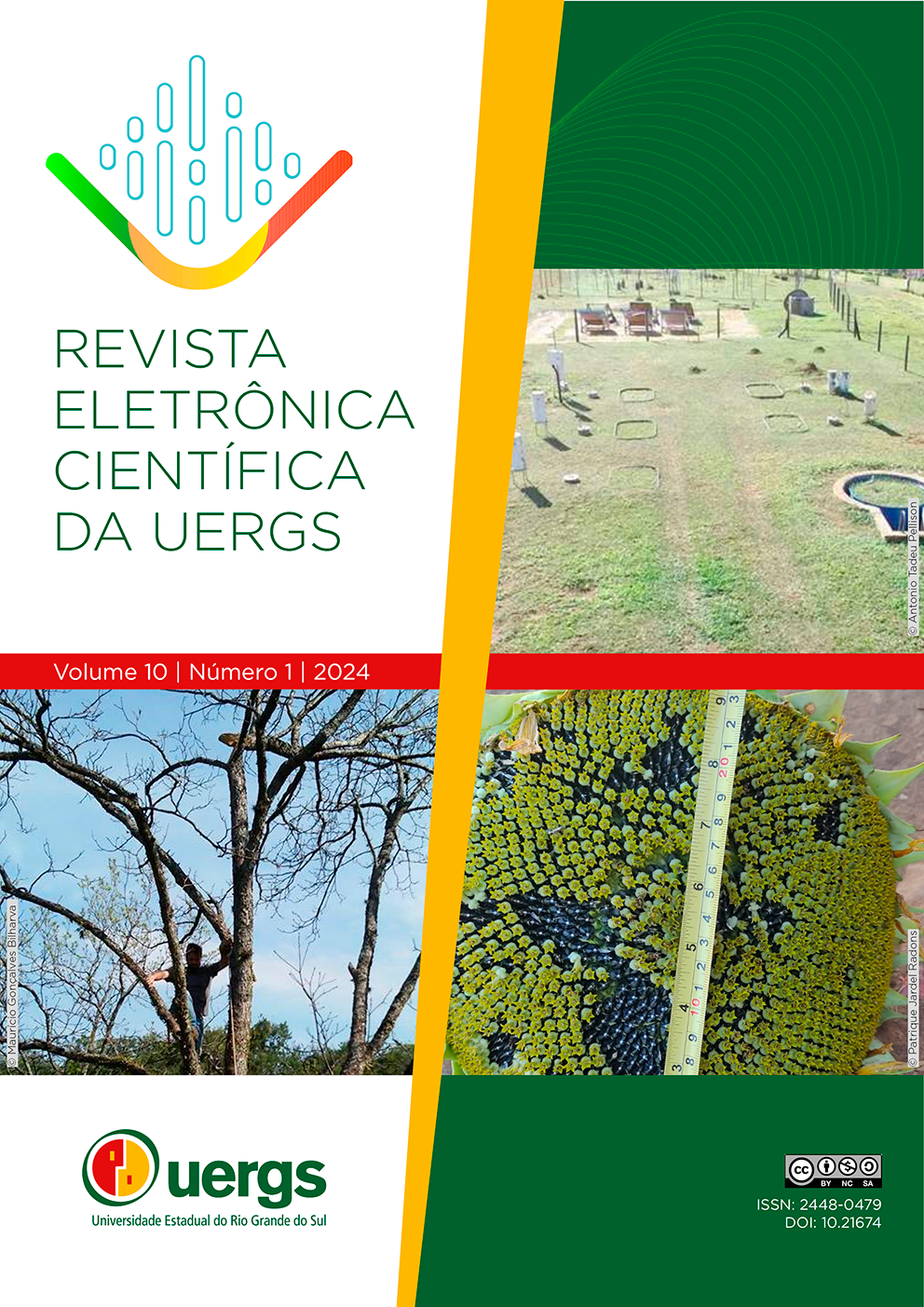Initial growth of sunflower plants grown under light environments
DOI:
https://doi.org/10.21674/2448-0479.101.3-12Keywords:
Helianthus annuus L., shading, luminosity, plant physiology, colored meshes.Abstract
Sunflower (Helianthus annuus L.) is an annual plant with high nutritional and productive value. Among the external factors that influence plant growth, light is one of the most important, as it acts directly on metabolic processes to obtain energy. However, there is a lack of information regarding the ideal light environment for sunflower cultivation, as it limitate the plant growth. Therefore, the objective of this work was to evaluate the influence of light environments on the growth and production of sunflower plants. The experiment was conducted in the greenhouse of the Federal University of Recôncavo da Bahia (UFRB), in a completely randomized design (DIC), with four light environments: full sun (control), red mesh, black mesh and aluminum mesh (both with 50% irradiance) and six repetitions, totalizing twenty-four experimental units. At the end of forty days, physiological growth parameters were evaluated. The data obtained were subjected to analysis of variance, applying the Tukey test, at a 5% significance level. Sunflower plants grown under light environments responded positively to light changes, promoting an increase in plant growth. The greatest growth in height was observed for plants grown in environments under the aluminet and red meshes. The use of black mesh reduced plant growth. The best development of sunflower plants was observed in full sun cultivation and with the use of the aluminet photoconverter mesh.
Downloads
References
BRITO, Gildeon. S. et al. Crescimento e anatomia foliar de Mikania glomerata cultivadas em diferentes ambientes de luz. Agronomia Avanços e Perspectivas, Pantanal editora, Mato Grosso, p. 06-16, 2020.
CASTRO, Cesar. et al. A cultura do girassol. EMBRAPA-CNPSo, Londrina, 1997. Disponível em: https://www.embrapa.br/busca-de-publicacoes/-/publicacao/445832/a-cultura-do-girassol. Acesso em: 15 mar. 2023.
CHAGAS, Jorge. H. et al. Produção, teor e composição química do óleo essencial de hortelã-japonesa cultivada sob malhas fotoconversoras. Horticultura Brasileira, v. 31, n. 2, p. 297-303, 2013.
DICKMANN, Lourdes. et al. Comportamento de sementes de girassol (Helianthus annuus L.) submetidas a estresse salino. Revista de Ciências Agro-Ambientais, Alta Floresta, v. 03, p. 64-75, 2005.
GUERRA, Maria. E. C. et al. Caracterização agronômica de ocimum gratissimum L. (alfavacacravo) e Ocimum sp (alfavaca-roxa) cultivadas em casa de vegetação e ambiente externo. Cultura Agronômica, v. 23, n. 2, p.123-134, 2015.
JESUS, Railda. S. et al. Características agronômicas de ora-pro-nóbis cultivadas em ambientes de luz e adubação orgânica. Brazilian Journals of Development, Curitiba, v. 6, n. 3, p.15048-15063, 2020.
LARCHER, Walter. Ecofisiologia vegetal. São Carlos, São Paulo: Rima, 2004.
LIMA, Janderson C. et al. Proporções de amônio e nitrato no crescimento de plantas de Lippia alba (Mill) N. E. Br. cultivadas sob ambientes de luz. Revista de Ciências Agrárias, v. 41, n.3: p. 655-662, 2018.
LIMA, Juliana D. et al. Efeitos da luminosidade no crescimento de mudas de Caesalpinia férrea Mart. Ex Tul. (Leguminosae, Caesalpinoideae). Acta Amazônica, Manaus, v. 38, n. 1, p. 5-10, 2008.
LORENZI, H.; MATOS, F.J.A. Plantas ornamentais no Brasil: arbustivas, herbáceas e trepadeiras. 4ª. Ed, Nova Odessa, São Paulo: Instituto Plantarum, 2008.
MATOS, Lavine S. et al. Rendimento de fitomassa de manjericão cultivado em diferentes ambientes de luz. Enciclopédia Bioesfera, Goiânia, v. 14, n. 25, p. 1136-1144, 2017.
NOHAMA, Mateus T. R. et al. Desempenho de salsa a sob diferentes telas de sombreamento. Horticultura Brasileira, v. 29, n. 2, p. 103-109, 2011.
OLIVEIRA, Vanuze C. et al. Respostas fisiológicas de plantas de orégano (Origanum vulgare L.) cultivadas sob malhas coloridas e fertilizantes orgânicos. Revista Colombiana De Ciências Hortícolas, Colômbia, v. 11, n. 2, p. 400-407, 2017.
OLIVEIRA, M. I. et al. Características biométricas, anatômicas e fisiológicas de Artemisia vulgaris L. cultivada sob telas coloridas. Revista Brasileira de Plantas Medicinais, Botucatu, v.11, n.1, p. 56-62, 2009.
PEIXOTO, Clóvis P. et al. Princípios de fisiologia vegetal: teoria e prática. Rio de janeiro: Pod Editora, 2020.
PINTO, José E. B. P. et al. Produção de biomassa e óleo essencial em mil folhas cultivada sob telas coloridas. Horticultura Brasileira, v. 32, n. 3, p. 321-326, 2014.
POLYSACK INDÚSTRIA LTDA. Malhas termorefletoras aluminizadas. Disponível em: http://www.polysack.com. 2022 Acesso em: 10 mar. 2023.
RAVEN, Peter. H. et al. Biologia vegetal. 7ª ed. Rio de Janeiro: Guanabara Koogan, 2007.
SILVA, Alexandre R. A. et al. Desempenho de cultivares de girassol sob diferentes lâminas de irrigação no Vale do Curu, CE. Revista Ciência Agronômica, Fortaleza, v. 42, n. 1, p. 57- 64, 2011.
SILVA, Mirian. L. O. et al. Crescimento e produtividade do girassol cultivado na entressafra com diferentes lâminas de água. Revista Brasileira de Engenharia Agrícola e Ambiental, v. 11, n. 05, p .482-488, 2007.
SOUZA, Girlene S. et al. Produção de fitomassa de Salvia officinalis L. cultivada sob malhas coloridas e doses de esterco avícola. Revista Verde de Agroecologia e Desenvolvimento Sustentável, v.12, n. 2, p. 182-186, 2017.
SOUZA, Girlene S. et al. Crescimento vegetativo e produção de oleo essencial de plantas de alecrim cultivadas sob telas coloridas. Bioscience Journal, Uberlandia, v. 30, n.1, p. 232-239, 2014.
TAIZ, Lincoln. et al. Fisiologia e Desenvolvimento Vegetal. 6. Ed. ArtMed: Porto Alegre, 2017.
Downloads
Published
How to Cite
Issue
Section
License
Copyright (c) 2024 Cristian Martins de Souza, Gildeon Santos Brito, Alfredo Teles de Jesus Neto, Girlene Santos de Souza

This work is licensed under a Creative Commons Attribution-NonCommercial-ShareAlike 4.0 International License.
A reprodução total dos artigos da Revista em outros meios de comunicação eletrônicos de uso livre é permitida de acordo com a licença Creative Commons Atribuição-NãoComercial-CompartilhaIgual 4.0 Internacional.

